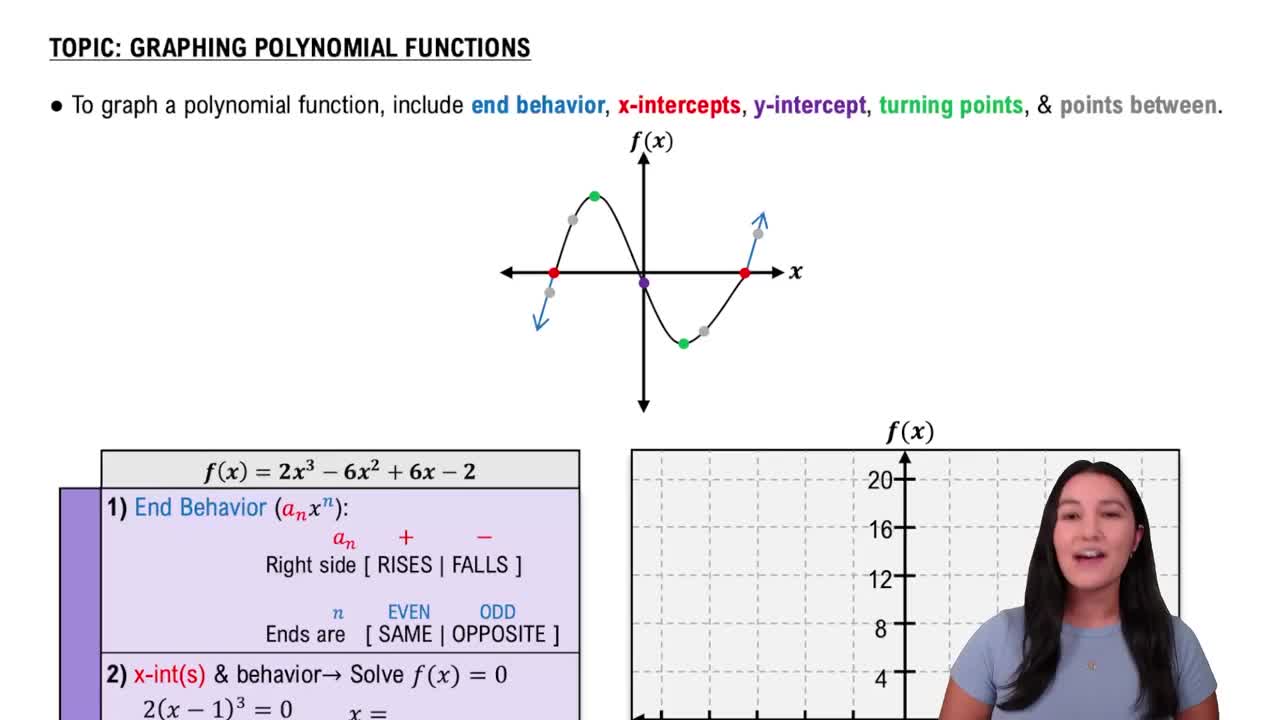Table of contents
- 0. Review of Algebra4h 16m
- 1. Equations & Inequalities3h 18m
- 2. Graphs of Equations43m
- 3. Functions2h 17m
- 4. Polynomial Functions1h 44m
- 5. Rational Functions1h 23m
- 6. Exponential & Logarithmic Functions2h 28m
- 7. Systems of Equations & Matrices4h 6m
- 8. Conic Sections2h 23m
- 9. Sequences, Series, & Induction1h 19m
- 10. Combinatorics & Probability1h 45m
4. Polynomial Functions
Zeros of Polynomial Functions
Problem 53
Textbook Question
Exercises 53–60 show incomplete graphs of given polynomial functions. a) Find all the zeros of each function. b) Without using a graphing utility, draw a complete graph of the function. f(x)=−x^3+x^2+16x−16
 Verified step by step guidance
Verified step by step guidance1
Identify the polynomial function: \( f(x) = -x^3 + x^2 + 16x - 16 \).
Use the Rational Root Theorem to list possible rational zeros, which are the factors of the constant term divided by the factors of the leading coefficient.
Test the possible rational zeros using synthetic division or direct substitution to find actual zeros of the polynomial.
Once a zero is found, factor the polynomial by dividing it by \( (x - \text{zero}) \) to simplify the polynomial and find other zeros.
Use the zeros and the end behavior of the polynomial (determined by the leading term \(-x^3\)) to sketch a complete graph of the function, noting that the graph will have a downward end behavior on both sides.
Recommended similar problem, with video answer:
 Verified Solution
Verified SolutionThis video solution was recommended by our tutors as helpful for the problem above
Video duration:
6mPlay a video:
Was this helpful?
Key Concepts
Here are the essential concepts you must grasp in order to answer the question correctly.
Polynomial Functions
A polynomial function is a mathematical expression involving a sum of powers in one or more variables multiplied by coefficients. The general form is f(x) = a_n*x^n + a_(n-1)*x^(n-1) + ... + a_1*x + a_0, where 'n' is a non-negative integer and 'a_n' is not zero. Understanding the structure of polynomial functions is essential for analyzing their behavior, including finding zeros and graphing.
Recommended video:

Introduction to Polynomial Functions
Finding Zeros
The zeros of a polynomial function are the values of 'x' for which f(x) = 0. These points are crucial as they indicate where the graph intersects the x-axis. To find the zeros, one can use methods such as factoring, the Rational Root Theorem, or synthetic division, depending on the degree and complexity of the polynomial.
Recommended video:

Finding Zeros & Their Multiplicity
Graphing Polynomial Functions
Graphing polynomial functions involves plotting points based on the function's values and understanding its general shape, which is influenced by the degree and leading coefficient. Key features to consider include intercepts, end behavior, and turning points. A complete graph can be sketched by identifying zeros, evaluating the function at various points, and analyzing the intervals of increase and decrease.
Recommended video:

Graphing Polynomial Functions
Related Videos
Related Practice


